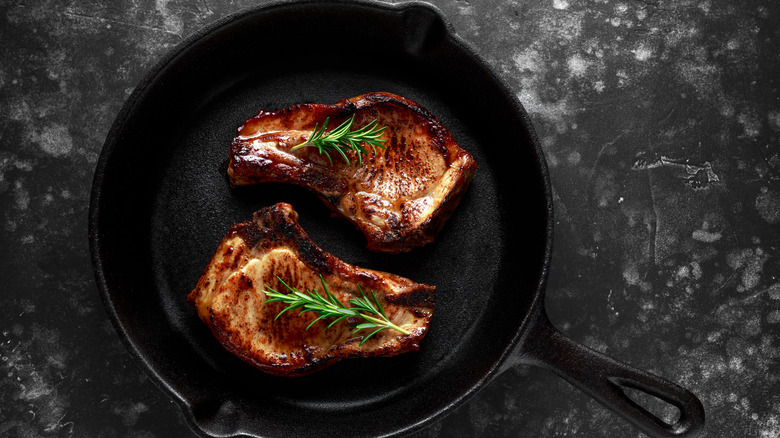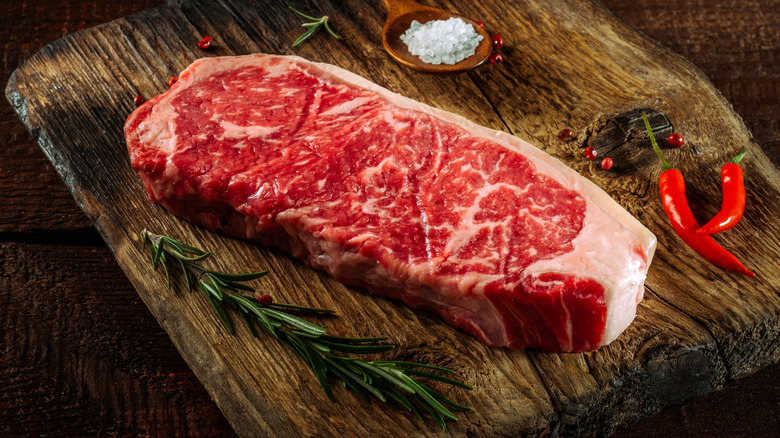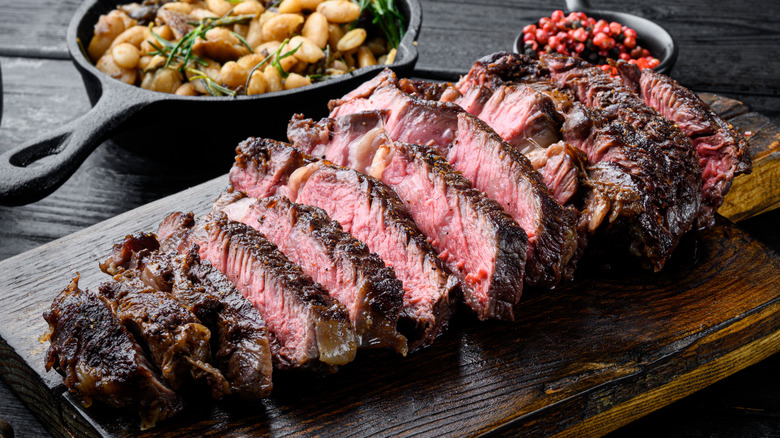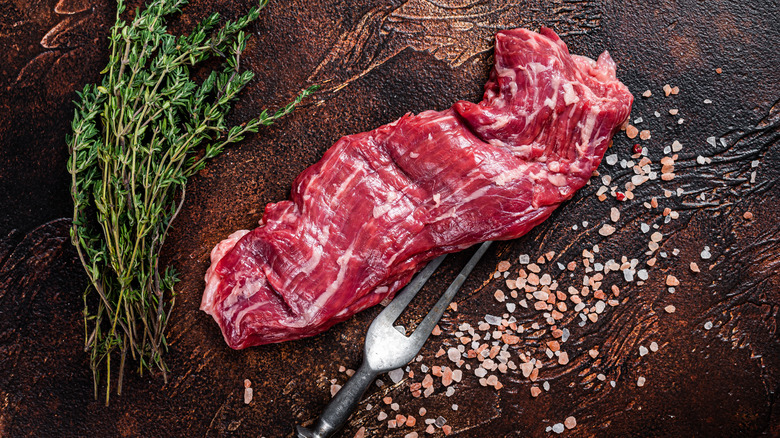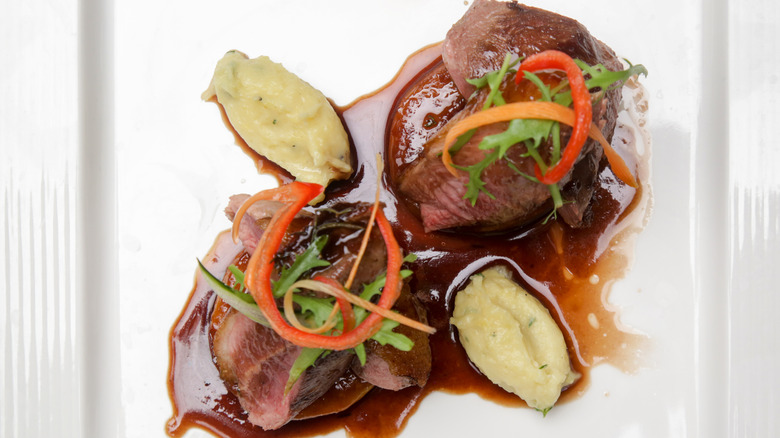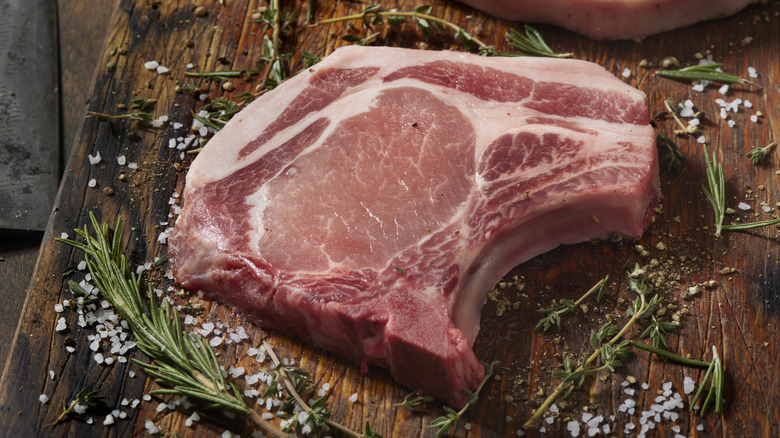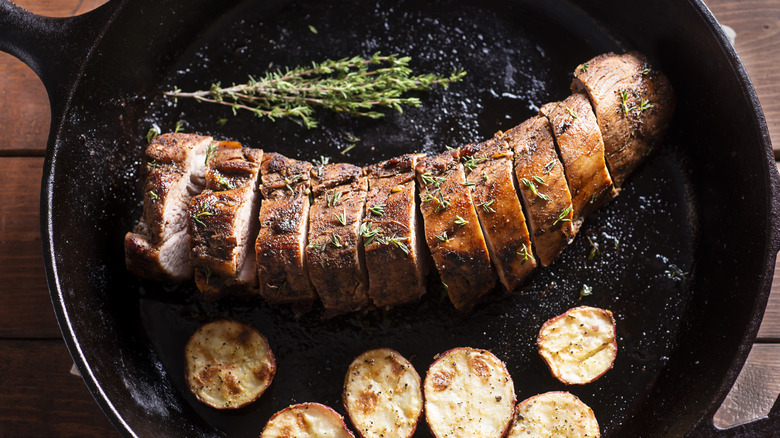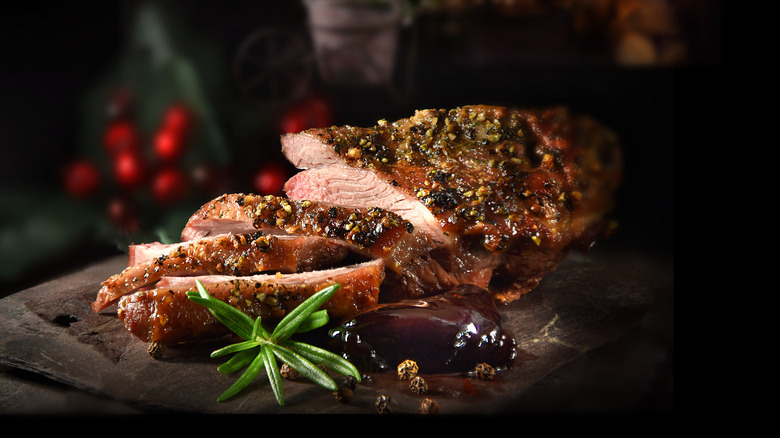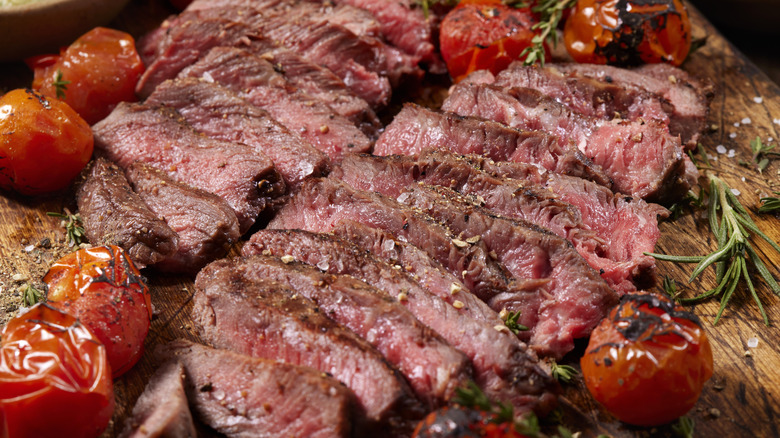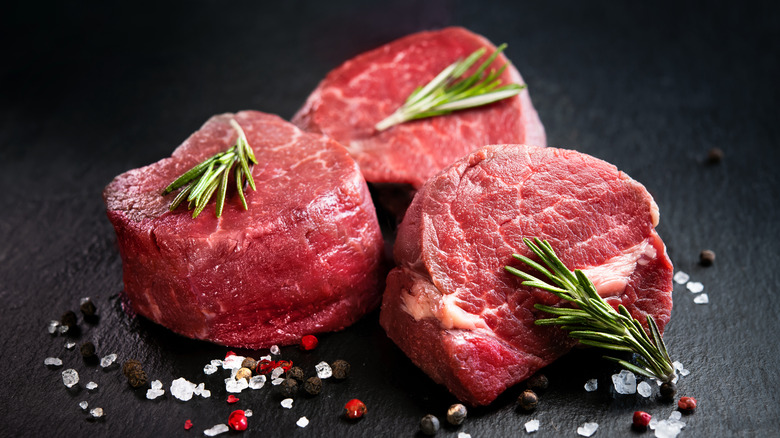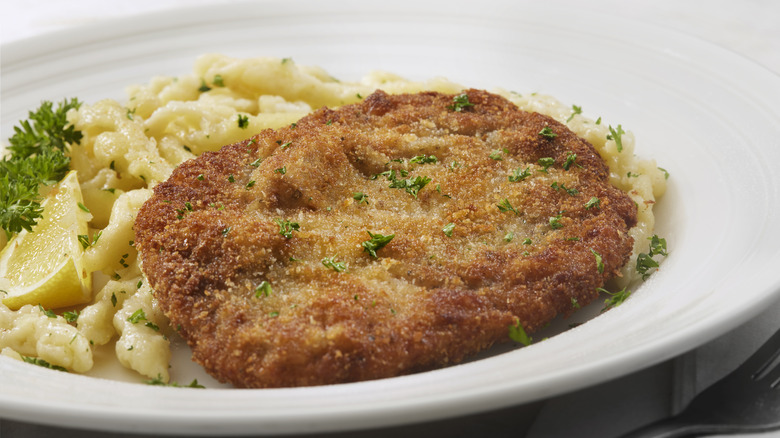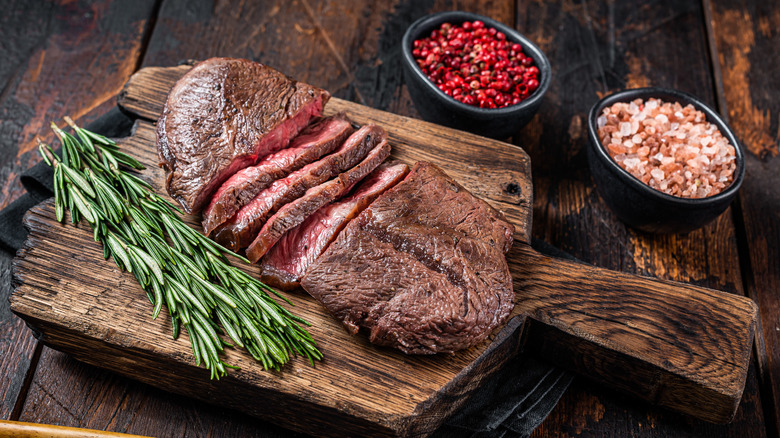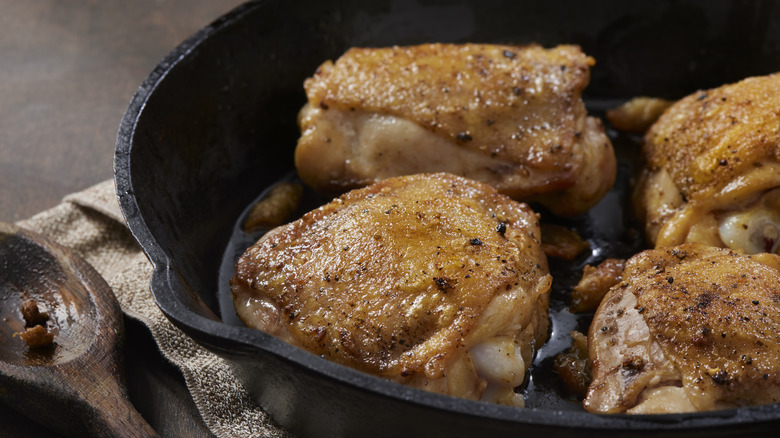12 Absolute Best Cuts Of Meat To Pan Fry
For meat lovers, a perfectly grilled steak or roast is always something to savor. But when that craving for meat hits on a busy weeknight, patiently warming up a grill or waiting hours for a roast to reach its optimal temperature are not ideal. For times like this, a quick, indoor cooking method is required, one that delivers equally flavorful results.
A perfect option for such occasions is pan-frying. Unlike grilling, it doesn't require special equipment or good weather. All that is required is a working stove and a frying pan that holds and conducts heat evenly and well (cast iron is ideal for this). Most important, however, is an appropriate cut of meat.
Pan-frying is a quick cooking method, so the ideal cuts are those that are inherently tender and don't require long cooking for tenderizing. Thick cuts (about an inch or an inch and a half in thickness) are ideal for juicier meat (thin cuts can work too, but only if quickly flash-fried). In addition, boneless cuts are preferable, since they cook more evenly than bone-in on the stovetop. Below, some great cuts that meet these criteria — and will help you quickly get a flavorful, meaty meal on the table.
New York strip steak
Propose a steak dinner to a serious carnivore, and they will have a very specific eating experience in mind: A thick, juicy chunk of beef, pink and succulent on the inside and attractively browned on the outside. It will be tender, yet powerfully flavored with a gentle chew, and substantial enough to keep them going until the next meal. In short, not just any steak will do. To feed such a dedicated meat lover, a pan-fried New York strip steak is an easy path to satisfaction.
One reason strip steaks work so well for pan-frying is that they're naturally tender – they come from the short loin, a group of muscles near the top of the rib cage, so they're more tender than cuts from active working muscle. They can also be well marbled, which ensures juiciness and flavor; it's a cut for diners who want their beef to taste assertively beefy.
There are bone-in strip steaks, but boneless steaks — which are preferable for pan-frying — are more common. Most are also thick enough to offer that satisfying chew steak lovers demand. Their rich flavor also makes them partner well with fresh, punchy sauces, such as a piquillo pepper vinaigrette.
Ribeye steak
Good news: Grilling isn't the only option for cooking a fabulous steak. While grilling gives steaks a distinctive, smoky flavor and a bit of char that some steak lovers consider essential, pan-frying will not only get that steak on the table faster, but if properly done, deliver it with an attractive, evenly browned crust. Even better, the fond (little browned bits left on the bottom of the pan after browning) make a great base for a pan sauce — another great way to get even more flavor out of an already flavorful steak.
But some steaks take to pan-frying better than others. Something thick, well-marbled, and preferably boneless is ideal, with one of the best cuts also being a favorite of the grill: boneless rib eye. As its name implies, it's a cut from the rib of a cow, generally from between the sixth and 12th ribs of the animal. It is comprised of muscle and fat not actively used for movement or weight bearing, so it's one of the more tender beef cuts. It's also well marbled, so if cooked properly, should come out richly flavored and juicy from the rendered fat. Try this nearly foolproof recipe; it makes the case that a pan-fried ribeye can have all the smokiness and flavor of grilled, and then some.
Skirt steak
While thicker steaks are ideal for pan-frying, thinner cuts can also be delicious; just keep a close eye on the stove and don't let them overcook. A great cut for a quick pan-fry is one typically found in fajitas: skirt steak. This cut comes from under the rib section of the cow and has an unusual appearance — the thin steaks have a loose grain and lots of marbling, which give them a ruffled look reminiscent of a pleated skirt (hence, the name).
Looking at these features together, it's easy to see why skirt steaks are ideal for fajitas and other pan-fried dishes. The loose grain not only contributes to a more tender mouthfeel, but absorbs marinades quickly — and marinades are not only a great way to punch up the flavor, but to ensure meat stays tender and juicy. The marbling also keeps the meat nice and juicy, ideal for recipes like this super-flavorful marinade.
In addition, the large proportion of surface area on the thin steaks ensure that every bite includes a bit of the flavorful browned crust. While the popularity of skirt steak in recent years means it's not the bargain it used to be, it's still more affordable than date-night steaks such as filet mignon.
Lamb noisettes
Lamb can be polarizing. While some people love its distinctively rich, gamy flavor, others find it too intense. But while lamb may not be for everyone, its devotees take it seriously — and in some parts of the world, it's the celebration meat of choice. While the best-known lamb dishes tend to be long-cooked (think of roast leg of lamb or braised lamb shanks) lamb also lends itself to quick-cooked, pan-fried preparations, provided the right cut is on the menu.
The ideal lamb for this purpose is something tender, so not a cut from a working muscle such as the leg. Consider lamb noisettes — boneless chops cut from the center of the lamb loin — as an ideal cut for pan-frying. While a bit lean, they are tender and flavorful. Traditionally, the modestly-sized medallions are wrapped in fatty ham before being pan-fried. They can be a bit pricy, but they're a great option when looking to pamper and impress dinner guests without spending a lot of time in the kitchen.
Pork rib chop
For many families, pork chops are a favorite item on the weekday dinner menu; they're relatively affordable, lend themselves to any number of flavorings, and are popular with both adults and kids. Most importantly for busy cooks trying to get a meal on the table after a full day of work, they can be relatively quick to cook, especially when pan-frying. But not any old serving-sized piece of pork will lend itself to this treatment. For a truly satisfying pork chop dinner, start with the right cut of meat.
A great cut for pan-frying is the pork rib chop. As its name implies, it is cut from the rib cage of the animal, and while it typically includes a bone, it still makes for a great pan-fried chop. The key to getting the most flavor from these chops is to give them enough cooking time to allow their fat to render and a flavorful brown crust to form. Treating them with a marinade first can further boost their flavor, as can pan-frying them with a flavorful sauce — such as in this recipe for creamy smothered pork chops.
Pork tenderloin
Whether it's beef, lamb, or pork, the tenderloin gets its name for good reason. The cut comes from muscle buried deep in the ribcage, where it doesn't have a lot of work to do, thereby making it tender indeed. For pan-frying, pork tenderloins are sometimes cut into medallions, which are not only quick to cook, but make attractive serving-sized pieces.
Another distinguishing trait of pork loin is it's an exceptionally lean cut. This makes it a good choice for those looking to control their consumption of animal fat, but it also means it needs to be cooked with care to avoid drying out or toughening. Marinating the meat is one way to help ensure tenderness and juiciness while adding extra flavor. But the most important tip to remember is to pan-fry tenderloin pieces quickly at a high temperature to ensure they stay juicy — then give them a few minutes to rest after cooking to make certain they stay that way.
Lamb rump
Lamb may not be as popular a choice as pork or beef for American diners, but it's worth seeking out if fond of venison, duck, or other deeply flavored, gamy meats. Because lamb is not widely popular, there are typically fewer cuts of lamb available at typical supermarkets than there are of other meats. Those who have a good butcher or a supermarket that takes special orders, however, have a lot more options.
Looking for a cut that will take well to pan frying? A lamb rump is well worth consideration. Also called lamb chump, it is tender and flavorful (like other cuts from the back of the animal) and can be either pan-fried whole then briefly baked, as a festive roast for a crowd, or cut crosswise into quick-to-cook chops. But while inherently tender, the lamb rump is a lean cut, so quick cooking is key to getting a great texture and flavor. Whether cooking it whole or as individual chops, make sure it stays juicy and pink on the inside. One lesson that nobody wants to learn the hard way is that when it comes to meat, well-done lamb rump is not welcome on anyone's plate.
Flank steak
Flank steak has always been a popular cut among home cooks, for a number of reasons. It's not only deeply flavorful, but it's also less expensive than many other special-occasion cuts, making it a great option when it comes time to feed a crowd festively yet affordably. It's also a lean cut with little marbling (it comes from the lower part of the chest), which makes it a good choice for calorie-counting meat lovers. Best of all for busy home cooks, it's easy and quick to prepare. These are all major factors in its favor, and pan-frying is a great way to showcase the flavor of this cut.
Indeed, the flat shape of flank steaks makes them a perfect cut for pan frying. While the cooking itself is fast, observing a few simple steps will always ensure tender, flavorful results.
For starters, generously salt (or marinate) the flank steak and let it come to room temperature before cooking. Next, sear it over high heat to brown, monitoring it very carefully to prevent overcooking — because flank steak is so lean, it's best rare or medium rare, and it's very easy to overdo things. When it's done, rest it several minutes before serving (this ensures the juices are fully re-absorbed into the meat before carving it), and don't forget to always slice it against the grain.
Filet mignon
The very words "filet mignon" evoke celebratory, special occasions: A candlelight birthday or anniversary dinner, a lovingly prepared home-cooked meal for someone special. The plump little round steaks, cut from the small end of beef tenderloins, have a well-earned reputation as the most tender, most delicately flavored of all the steak cuts. They are also among the priciest, which is the main reason most folks would only consider indulging in them on rare occasions.
Despite its rarified reputation, filet mignon is not all that difficult to cook. Treat it pretty much like any other thick steak, and consider pan-frying it, because that is a great option for cooking filet mignon at home. Like other steaks, filets mignons should be seasoned and brought up to room temperature before pan-frying, and should be cooked in a thoroughly pre-heated heavy pan, such as a cast iron skillet. (Thicker steaks can be pan-seared, then baked to complete cooking.) To augment the mild flavor of filet mignon, some cooks like to wrap the filets in bacon before cooking. Its inherently subtle flavor also means it pairs well with flavorful sauces, so make sure to have some on hand.
Pork cutlets
While thick, juicy chops and steaks are easy to love, thinner, cheaper cuts don't get the respect they deserve. But what they lack in glamor they make up for in practicality and flavor' the thin cuts of pork or beef are always available in supermarkets, because smart cooks know that with a package of these on hand, they can prepare a meal everyone will love in just minutes, and for a fraction of the cost of a steak dinner. In short, they are the perfect centerpiece for a weeknight dinner.
So, when doing the weekly shopping, don't overlook the less-glamorous thin cuts. One worth looking out for is pork cutlets — lean, thin, boneless pork chops, sometimes cut from the pork tenderloin. Like other lean cuts, pork cutlets have the potential to toughen if overcooked, so they need to be cooked quickly at high heat. They can be quickly seared in a hot pan or, more traditionally, pounded thin and breaded before being pan-fried. The pounding further tenderizes the meat, while the breading offers extra flavor and crunch.
Flat iron steaks
For those folks craving a big, beefy, rare steak that don't want to break the bank, a flat iron steak is ideal. While it's a bit homely compared to classic steakhouse fare like rib eyes and filet mignons (as its name suggests, it's a large, rather flat cut), it packs a lot of flavor. It's a bit of an unexpected cut for a steak, since it comes from a part of the animal notorious for its toughness, the shoulder. However, creative butchers have devised ways to carve out steaks that include well-marbled, flavorful muscle while avoiding unappetizing sinews and connective tissue.
It's also a large cut, making it perfect for feeding a group of meat-loving friends. Because of its flat shape and even thickness, it's also perfect for pan frying. Like other steaks, flat iron steaks benefit from being generously salted and brought up to room temperature before cooking. Most flat iron steaks are thin enough that a quick sear (two to three minutes per side) should be sufficient for a medium rare steak. For additional flavor, some cooks soak the meat in a marinade first or top it with infused butter after cooking for extra flavoring. Once the steak has rested after cooking, slice it against the grain and serve with chimichurri or another flavorful sauce if desired.
Chicken thigh
Sometimes it seems that every restaurant on the planet is boasting about its all-white-meat chicken sandwiches or salads, as if this were a special point of honor. And sure, diced or sliced chicken breast makes for better food photos than dark meat. But true chicken lovers know the truth: When it comes to juiciness and flavor, chicken thighs rule the roost.
While white meat is leaner and less caloric (a big reason for its popularity), dark meat (such as that found in chicken thighs and drumsticks) is fattier and therefore moister and more flavorful. This gives it another advantage as well: Unlike chicken breasts, which can go from perfectly cooked to cardboard in mere seconds, chicken thighs are nearly impossible to overcook.
Because of this, chicken thighs not only lend themselves to long, slow braises, but to relatively quick pan frying. For an easy, one-pan entrée that's sure to satisfy, try this recipe for pan-fried chicken thighs. Easy to make with ingredients most people would already have on hand, it requires just a few simple steps: Season the thighs with salt, pepper, and herbs, sear until brown, then gently cook in a simple sauce of butter and chicken broth. Add some crusty bread to sop up the sauce, as well as a simple salad, and the end result is a great meal, ready to please with one of the best pan-fried meats around.
